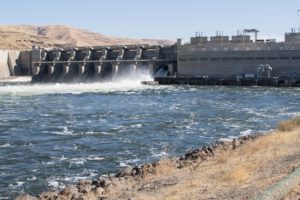
Bonneville Power Administration and the Lower Snake River Dams
Printable PDF
The Bonneville Power Administration’s future has begun to look like that of the Clearwater River’s wild B-run steelhead, with declines in both connected to the lower Snake River dams.
In 2010 BPA’s average preferred customer wholesale electricity rate was $26.82 per Megawatt hour (MWh). Today that rate is $35.57, an increase of 32%. BPA also recently announced a likely 2% surcharge to recover costs associated with increased “spill” ordered by a federal court to assist juvenile fish passage. A BPA press release identified three driving forces behind the agency’s most recent increase of 5.4%. “The overall rate increase is primarily due to a lower-than-expected demand for power, a declining forecast of surplus power sales revenues due to lower market prices, and escalating costs of programs driven by legal requirements.” What lies behind these economic forces?
1. The Northwest Power and Conservation Council’s 7th Power Plan, released in 2016, acknowledged a 16% power surplus in the Pacific Northwest (PNW) and concluded that any increased demand over the next 20 years will be made up entirely through conservation. Meanwhile, the cost of PNW wind and solar energy continues its steady decline, and the owners of new power-hungry server farms (e.g. Apple) are producing their own power or purchasing it from providers outside the BPA system. An Idaho Power Company spokesperson recently referred to the PNW power surplus as an energy “glut.”
2. Since the turn of the 21st century, cheap natural gas has resulted in the addition of over 5,000 annual Megawatts (aMW) of power to the Pacific PNW grid. Add in new PNW wind energy over the same period, and these two sources of power now produce nearly nine times the annual production of all four LSR dams.
3. Historically, BPA has beefed up its bottom line with sales of surplus power on the spot market; that is, power not contracted to preferred customers such as public utility districts. The price of power on the spot market touched $58 per Megawatt hour (MWh) in 2008, hovered around $30 per MWh 2010-2014, and dropped into the low $20s by 2016. California, previously a major customer for power on the spot market, is experiencing rapid growth in solar energy. BPA’s surplus power sales in 2012 totaled $348 million. In 2016 those sales added just $182 million to BPA’s coffers, a decline of 48%. In 2018 and into the future, with less demand and falling prices, BPA’s spot power revenues will likely continue to decline.
4. The “legal requirements” BPA cites as another cause for its rising wholesale power price are primarily mitigation costs for the loss of fish and wildlife caused by the federal dams, including Snake River salmon and steelhead. Mitigation costs in FY 2016 were $622 million, reported to be 33% of BPA’s power production costs. After nearly 20 years of mitigation efforts and the expenditure of billions of ratepayer dollars, some Snake River wild fish runs were recently described in Idaho newspapers as being in a state of collapse and in serious jeopardy of extinction.
5. In 2007, BPA had financial reserves of $917 million. Fitch Ratings, along with Moody’s and Standard and Poor’s one of the nation’s top three bond rating agencies, notes that at the end of FY 2015, BPA had $395 million in its power business reserves, with estimates of reserves in 2017 of just $11 million. BPA included in its power rate request a plan to increase its reserve account to a minimally acceptable $300 million by including an additional $20 million per year in its budget. At that pace, ratepayers will pay higher electricity bills to replenish BPA’s reserves to a minimal level for the next 15 years.
6. In providing a 2017 “negative rating outlook” for BPA-backed bonds, Fitch Ratings noted that BPA “faces the issue of aging infrastructure and delayed capital investment.” The agency has “high debt burden, rate pressures, and financial variability of net margins for a hydroelectric utility.” Fitch Ratings summarized: “In recent years the competitive margin between Bonneville’s power rates and market alternatives compressed due to very low natural gas prices, increased generation from renewables, declining energy demands in the region and increasing costs at Bonneville.”
With that dismal outlook, we must consider the issue of the four lower Snake River (LSR) dams. These dams and their respective reservoirs contribute significantly to the ongoing collapse of Snake River threatened and endangered salmon and steelhead. They also contribute to BPA’s constantly rising costs for fish and wildlife mitigation and hence overall BPA power production. However, even greater costs loom on the horizon.
In its 2002 Lower Snake River Juvenile Salmon Migration Feasibility Report, the Walla Walla District of the Corps of Engineers stated that the 24 turbines in the LSR dams each has a useful life of 35-45 years. Nine LSR turbines are older than 45 years, six exceed 40 years, and the remaining nine will reach the upper end of their projected useful lives by 2025. Two turbines (Ice Harbor) are presently being rehabbed at a cost approaching $100 million. The Corps has budgeted turbine rehabilitation at McNary Dam on the Columbia for $46 million per unit. At $46 million each, the total price for rehabbing twenty-four turbines on the lower Snake would be over one billion dollars—all to be borne by BPA ratepayers.
Fitch Ratings called attention to the predictable results of BPA’s long-delayed asset investments. “Many assets will also be forced to operate well beyond their design lives, posing a significant maintenance burden in the future in order to keep assets in service until their replacement dates.” For most of the LSR dam turbines, the end of turbine design life is already here.
The future of salmon and steelhead runs in Idaho, both wild and hatchery, greatly depends upon the presence of a fish-friendly migratory corridor for both juvenile and adult salmon and steelhead. For example, according to a recent report from the Fish Passage Center, the return of the lower Snake to a more natural flow through dam breaching, combined with increased spill at the lowest four dams on the Columbia, would result in a four-fold (400%) increase in adult salmon reaching Idaho. Once past Lower Granite Dam 30 miles west of Lewiston, over 5,000 miles of America’s best salmon and steelhead spawning rivers and streams await them. For those interested in salmon and steelhead recovery and a sustainable fishery, as well as all BPA electrical ratepayers throughout the PNW, BPA’s decision to breach or maintain these aging dams is highly significant. What course might BPA choose?
The agency could double down on its false claim that juvenile and adult fish passage at lower Snake River dams is not a problem while ignoring juvenile survival rates through the hydro system of just 50% due to slow travel times through reservoirs, elevated water temperatures, and fish predation—as well as dam passage itself. That 50% figure does not include further loss due to avian predation below Bonneville Dam and what fish biologists call delayed mortality caused by the cumulative impact of passage through 8 dams and reservoirs. In this BPA scenario, one that closely resembles current reality, the agency would continue to feed the misinformation echo chamber perpetuated by the agency’s federal partners and the special interest groups that support freight navigation, hydropower and irrigation. This scenario would call for stretching out the current federal court-ordered NEPA/EIS process, challenging the need for and benefits of additional spill for juvenile fish passage, and unquestionably supporting the 4 LSR dams as long as possible. Such a plan would also logically call for a financial commitment to the timely rehabilitation of all 24 LSR turbines—as noted above, a huge, long-term ratepayer-funded financial commitment.
A second alternative would be to let the LSR dam turbines run themselves out, bolstered by only minor repairs, and to take turbines off-line when they pose a safety risk or are simply dead. Supporting this alternative, BPA’s Large Capital Investment Forecast FY2016-FY2035 includes major investments in Grand Coulee and McNary dam turbines, but only limited amounts for the 4 LSR dams spread over the 20-year forecast period. Notable as well, the forecast includes no funds for repair and rehabilitation of aging hatchery and fish passage facilities. Like LSR freight transportation over the past 20 years, in this scenario power production would steadily decline, further undermining claims about the importance of the dams in the PNW power grid.
In a third scenario, BPA could acknowledge the major changes occurring in the power markets, the serious aging of the LSR dams’ infrastructure, and the dramatic decline of Snake River salmon and steelhead with no meaningful progress toward the recovery of threatened and endangered species. The agency might further recognize the plight of endangered southern resident killer whales in the Salish Sea, starving to extinction without an adequate supply of Chinook salmon. BPA could also acknowledge that the limited amount of power produced by the four LSR dams is not worth the economic, ecological and legal costs of maintaining them. (A related observation: Congressional authorization to maintain these dams, their turbines and the navigation channel, should not be seen as, and is not, a Congressional mandate.) BPA could also publicly recognize that it cannot compete in the power market with a burdensome 33% add-on cost for fish and wildlife mitigation that its competitors do not face, and that its customer base will dwindle after 2028 when its 20-year contracts with many of its preferred customers end. In this scenario, if the agency harbored any interest in being socially responsible, BPA management would advise communities in south-eastern Washington and north-central Idaho of the agency’s intent not to rehab the turbines in the LSR dams so the few industries that still use the river for freight transportation could accelerate the shift to rail that is already occurring.
Other alternatives exist. For example, BPA could support efforts to abolish the Endangered Species Act or join irrigators from the Ice Harbor pool in their effort to have the federal government allow wild Snake River salmon and steelhead become extinct. New breakthroughs in power production and distribution over the next few years will also undoubtedly impact this situation and may inevitably sway the direction of decision-making regarding the LSR dams. Waiting for that to happen on its own will likely doom some Snake River wild salmon and steelhead populations.
A final note: during the last 15 years a new set of Snake River realities has emerged. Almost all industries that once used the LSR for freight transportation have abandoned the river, and freight volumes have declined by over 50%. With a 16% power surplus projected to last over the next 20 years, the LSR dams produce just 6.5% of the PNW’s hydropower. PNW wind energy alone has three times the capacity of all four LSR dams combined. The expenditure of billions of ratepayer dollars has not saved threatened and endangered Snake River salmon and steelhead. Projecting a recovery period for these fish of 50-100 years, the federal government’s 2017 Recovery Plan “contains an extensive list of actions” costing hundreds of millions of dollars. Unbelievably, the plan also states “the actions will not get us to recovery.”
Burdened by a 33% overhead cost not experienced by its competitors, falling demand for its product, and fish recovery requirements it cannot meet, BPA faces stark challenges.
The status quo on the lower Snake River is no longer cast in concrete.
Linwood Laughy Moscow, Idaho lochsalaughy@yahoo.com
